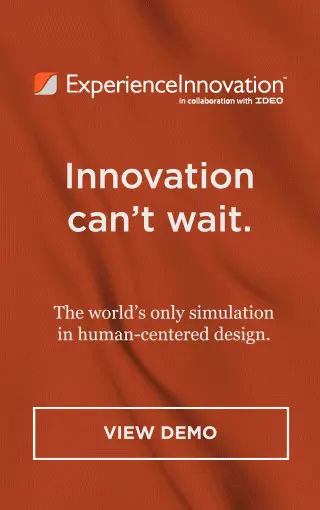As an innovation leader, you are well aware of the need to bring more human-centered approaches to talent, challenges and working methods. You know that companies who live and breathe their customer’s needs bring in almost 6x more revenue than their competitors. You know that customer-obsessed and innovative companies harness the power of design thinking, yet you haven’t been able to leverage the approach yourself.
Design thinking is not an easy plug-and-play, and many organizations have the scars to prove it. To overcome a false start, organizations need to treat the approach to innovation training as a transformation that helps employees solve problems from the outside-in. In this blog, we dive into the key ways organizations learn to embrace design thinking training and how ExperiencePoint helps them throughout the process.
The Five Keys to Embracing the Design Thinking Framework

-
-
Spread design thinking knowledge to everyone
Design thinking knowledge must reach every nook of your organization if you want to truly embrace the approach. Having team members from various levels and departments participate in training is the best way to spread information in a manner that is accessible (just a chat or walk away) and natural (not mandated by the c-suite). Participant variety also builds momentum; as quick wins echo throughout the company, the drive to do better work becomes contagious to every department. Different people will have different proficiency levels, but everyone needs a shared understanding to embed the approach into the work culture. Therefore, providing innovation training accessible to every participant, regardless of experience level or journey-entry point, is critical to your initiative’s success.We help by providing carefully crafted innovation workshops for specific roles.
ExperiencePoint helped one of the most recognizable food and beverage brands to build design thinking capability across their European operations by tailoring learning experiences to specific roles. To start, the organization’s top 120 leaders engaged in ExperienceInnovation™ | Apply as part of their annual leadership summit. All other employees were subsequently trained in ExperienceInnovation™ | Learn by colleagues who had been through our program Train-The-Trainer. Moving forward, the brand’s global leaders that achieved a specific tier of leadership went through the ExperienceInnovation™ |Aware workshop to start globalizing the incredible momentum Europe had demonstrated. The training initiative saved the organization $250,000 within the first three months of working with ExperiencePoint, with those savings expected to repeat every quarter in perpetuity.
-
Develop and apply new skills
As you have come to learn, It's not enough to simply develop problem-solving skills through design thinking; you must also be able to turn them into real business outcomes. Successful design thinking training combines hands-on learning with in-the-business problem solving so that employees can easily apply new skills back on the job and excel at action-oriented projects.
We help by providing application-focused workshops.
ExperiencePoint helped a leading pediatric research and care center solve a perpetual need for medical beds by enabling families to feel more secure in taking their discharged children home. The center’s medical staff was trained in design thinking with ExperienceInnovation™ | Learn and then invited to apply their learnings in a hands-on design sprint through ExperienceInnovation™ | Apply. The design thinking principle of empathy helped the team understand that the primary restraining force to leaving the hospital was how disruptive it could be for other children in the home. With this insight, the center developed better solutions for outgoing families and incoming patients, slowing down the demand for beds and alleviating pressure on staff.

-
-
Support new behaviors
Innovation isn’t just about coming up with new ideas. Leaders also need to create environmental conditions where people are encouraged to adopt these new ways of working. By providing a clear framework or process for teams to follow, organizations give workers the space and time to validate new skills, maximizing the impact of new behaviors.We help by running design sprints.
ExperiencePoint helped a financial services powerhouse improve its innovation skills by running a design sprint through ExperienceInnovation™ | Apply. In the design sprint, a core team of contributors, comprised of process owners, HR leaders, and other influential executives, were able to identify and execute policy changes that made it easier for all company employees to meet client needs. Impressed by the results, the organization’s executive leaders were subsequently trained in ExperienceInnovation™ |Aware, continuing to spread enthusiasm from the top down and sustaining early momentum. The rest of the organization then joined their leaders to be trained in ExperienceInnovation™ | Learn, learning how to conjure their new problem-solving skills on demand. Workers all over the organizations felt motivated by their new sense of capability, and higher employee empowerment and engagement scores were reported, particularly in innovation. -
Foster a community of practice
Self-sufficiency is key to sustaining organizational change; it’s achieved through a community of practice made up of change catalysts and internal facilitators that provide proactive and reactive support, building internal expertise in the process. Whereas external experts abandon employees to apply learnings on their own, a community of practice allows workers to turn to internal expertise for timely guidance, maximizing the effects of training.
We help by developing a community of catalysts.
ExperiencePoint helped a leading CPG (consumer packaged goods) firm build a community of catalysts that would boost innovation. We supplied the methodology, processes, and templates for evaluating and recruiting catalysts and securing the support and commitment of their leaders. ExperienceInnovation™ | Learn introduced design thinking capability to catalysts, while ExperienceInnovation™ | Impact tested their learnings through a design sprint. We partnered with the company to help catalysts connect with their communities by giving them the capabilities, visibility, and legitimacy required to lead. In addition to certifying these catalysts to train their own colleagues via our Train-the-Trainer program, we provided them with extra support through catalyst coaching and our Spark by ExperiencePoint™ program. Launched over four years ago, the CPG’s community of practice remains strong until this day. -
Sustain change by demonstrating outcomes
An essential part of embracing design thinking is enabling and recognizing quick business impact wins. Quick business impact wins keep the momentum on adapting new behaviors, fuelling that virtuous cycle of continued improved business results, which is what organizations need to see to buy into design thinking. Emphasizing these business impact wins and sharing them through specific protocols ensures that organizations do not give up before seeing a payoff.
We help by offering enterprise services.
ExperiencePoint helped a global eCommerce leader establish the right conditions for design thinking to thrive by providing catalyst and team coaching with business outcomes as the goal. ExperienceInnovation™ | Learn and ExperienceInnovation™ | Impact was first used to give training participants real project experience and in subsequent months and years, we used Lead by ExperiencePoint™ and Spark by ExperiencePoint™ to hone the company’s leadership skills and support practitioners. With the help of our enterprise service team, we facilitated the design of their communication and sustainment strategies, which included establishing catalyst infrastructure and tailoring it to fit their needs as their capabilities increased, such as developing governance models for supporting project work with the appropriate Catalyst talent. Ultimately, we helped establish clear KPIs from the programmatic to the behavioral, laddering ultimately to perception and project while also offering protocols to help people demonstrate outcomes.Learn more about our in-depth beginner design thinking course, Experience Innovation™ | Learn.
-
Begin your 5-step journey to embracing customer-centricity
Companies that live and breathe their customer’s needs bring in nearly 6x more revenue than their competitors.
Download this free eBook to get the secret sauce to customer satisfaction.
.jpg?width=717&height=375&name=LinkedIn_1200x627_3B%20(1).jpg)